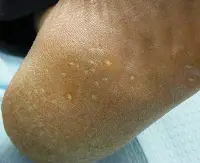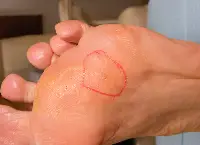porokeratosis
AUTHOR: Marc Mitnick DPM home --> porokeratosisWHAT IS A POROKERATOSIS
Many people suffer from painful growths on the bottom of their feet. The origins of these growths are varied. The most common growth on the bottom of the foot that may be painful is known as a callus, which is a broad layer of hard skin similar in appearance to the calluses one develops on their hands after doing labor like raking leaves.
However, some people develop small hard growths usually more than one on the bottom of their feet, many will complain they feel like they have a stone in their shoe. Although there are potentially many origins of this type of lesion including warts and intractable plantar keratoma, a very common cause of this type of growth is known as a porokeratosis.
Porokeratosis is a general term to a group of dermatological problems that occur in various parts of the body. This discussion is limited to punctate porokeratosis. These lesions are described as dozens of discrete or grouped seed-like hyperkeratotic lesions with characteristic thin, raised ridge-like margins that develop on the palms and the soles. Patients usually have other forms of porokeratosis as well, most commonly the linear or Mibelli types. Because of their description many patients will refer to them as seed corns.
These lesions generally occur on the weight bearing part of the foot which is the ball of the foot and the heel but may also occur in the mid arch. These lesions are generally not associated with any bony prominence as is the case with a callus or an intractable plantar keratoma.

|
These lesions are thought to be nothing more than plugged sweat glands however there is some debate as to whether this is true or not. In any event if you consider that the feet can have as many as 250,000 sweat glands it is easy to see how some of them could get "clogged" from constant friction and pressure and cause this condition to occur.
Any suspicious growth on any part of the body should be examined by a health care professional to determine if there is a possibility of malignancy. Porokeratosis are not malignant growths but should be looked at by a doctor to make sure.
The degree of discomfort a patient will experience will vary from person to person. In many people they are a non-issue but in others they can be very painful.
Factors that may exacerbate the pain include:
- the number of lesions
- their location on the foot
- the type of shoe a patient wears, thin soled shoes are worse then cushioned shoes
- the amount of walking a person does during the course of a day
- the amount of, or lack of fat on the bottom of the foot.
TREATMENT OF POROKERATOSIS
For this reason there are various treatments ranging from absolutely nothing to surgical excision. In cases where there is pain during ambulation most podiatrists will attempt to curette (carve out) the lesion(s) from the surrounding skin.

|
- In most cases, curetting the lesions can be done without anesthesia and is not a particularly painful procedure. This is usually what I do the first time a patient presents with this type of problem. Based on recurrence, if any, will determine further treatment. Many times curetting the lesion(s) will be the first and last treatment for these lesions. In other cases after a period of relief ranging from a couple of days to a few years the patient may return complaining of pain in the same area. If it has been a fairly long time since last treatment I may just go ahead and curette the lesion again.
- Wearing a cushioned innersole, although it will not rid you of the porokeratosis may reduce the pressure on these lesions and make it more comfortable to walk.
- In other instances if it has been a short period of time and the lesion has returned we need to look at other options. Other forms of treatment for porokeratosis plantaris include the use of keratolytic agents such as salicylic acid whose goal is "eat" away at the lesion by macerating the area. This can be done alone or in conjunction with curettement in an effort to extend the period of relief.
- These lesions may also be injected. Cortisone injections are usually of no value but sclerosing agents such as 4% denatured alcohol can be effective. The problem here as you might imagine is that an injection directly into the bottom of the foot can be very painful. Usually it is necessary to give a nerve block at the level of the ankle which will numb the whole bottom of the foot, then the lesions may be injected directly locally with the sclerosing agent. It should be noted that sclerosing injection therapy may require upwards of three injections given over a three week period into each painful lesion. If there has not been significant improvement after three injections, this therapy should be discontinued.
- Complete surgical excision of these lesions particularly those on the ball of the foot is not the treatment of choice. The problem here is that should there be an scarring as a result of the surgical procedure, the resulting scar may end up being more painful than the original growth.
REFERENCES
American Osteopathic College of Dermatology
Want more information? CLICK HERE
Para traducir esta pagina, ve al boton de traduccion de Google en las esquina superior derecha de la pagina


Recent Articles
-
Vitamin D impact on health
Feb 06, 23 07:17 PM
Researchers are suggesting that the effectiveness of Vitamin D in fighting and preventing disease is predicated on a persons body mass index (BMI). The thinner the person the greater the positive impa… -
Foods to speed up healing
Feb 01, 23 02:41 PM
One of the best ways to help yourself heal faster after surgery is to eat well. Getting the proper nutrition will provide your body with the essentials it needs to promote healing. Here is a suggestio… -
Cancer and Type 2 Diabetes
Jan 25, 23 04:52 PM
An article revealing that older type 2 diabetics have a higher incidence of cancer then non-diabetics. It is suggested that cancer may surpass CVD as the number one cause of death in older diabetics. -
Does glucosamine or MSM reduce arthritis pain?
Jan 22, 23 01:41 PM
A good review of the possible benefits to taking glucosamine, chondroitin or MSM for arthritis. Always beware of the possible side effects of over the counter supplements. -
shin splints
Jan 18, 23 05:12 PM
A great review on the various causes of shin splints, along with treatment options. -
Whats new in skin cancer?
Jan 15, 23 08:32 PM
A presentation of newer skin protection combinations in an effort to better protect the skin from the hazards of sun exposure. -
Causes and risk factors of warts
Jan 14, 23 05:02 PM
A good review of the causes of warts and protective measures you can take to prevent developing them. -
Do chronic wounds need to be dressed daily?
Jan 11, 23 02:18 PM
Because of supply chain shortages as well as staffing shortages particularly during the pandemic, many institutions extended the time between dressing changes for chronic wounds. Is this really the be… -
Food choices that raise your risk of type 2 diabetes
Jan 08, 23 10:07 AM
A good review of how blood sugars can become elevated and the harm that can do. Certain food groups have a tendency to raise your blood sugars and should be avoided. -
Outcome stats from Scarf bunionectomy
Jan 03, 23 03:04 PM
The Journal of Foot and Ankle Surgery recently reported a meta analysis of outcomes in 1583 Scarf bunionectomies that met their inclusion criteria. Adverse events did not seem to be any better or wors…